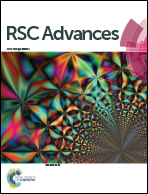Bimetallic Au–Pd alloy nanoparticles supported on MIL-101(Cr) as highly efficient catalysts for selective hydrogenation of 1,3-butadiene†
Abstract
Gold–palladium (Au–Pd) bimetallic nanoparticle (NP) catalysts supported on MIL-101(Cr) with Au : Pd mole ratios ranging from 1 : 3 to 3 : 1 were prepared through coimpregnation and H2 reduction. Au–Pd NPs were homogeneously distributed on the MIL-101(Cr) with mean particle sizes of 5.6 nm. EDS and XPS analyses showed that bimetallic Au–Pd alloys were formed in the Au(2)Pd(1)/MIL-101(Cr). The catalytic performance of the catalysts was explored in the selective 1,3-butadiene hydrogenation at 30–80 °C on a continuous fixed bed flow quartz reactor. The bimetallic Au–Pd alloy particles stabilized by MIL-101(Cr) presented improved catalytic performance. The as-synthesized bimetallic Au(2)Pd(1)/MIL-101(Cr) with 2 : 1 Au : Pd mole ratio showed the best balance between the activity and butene selectivity in the selective 1,3-butadiene hydrogenation. The Au–Pd bimetallic-supported catalysts can be reused in at least three runs. The work affords a reference on the utilization of a MOF and alloy nanoparticles to develop high-efficiency catalysts.



 Please wait while we load your content...
Please wait while we load your content...